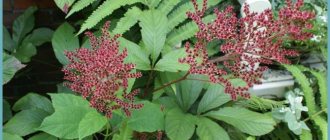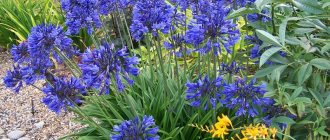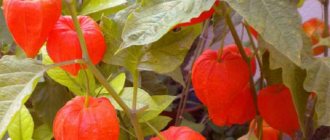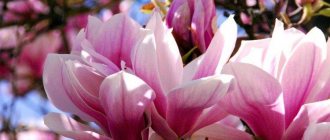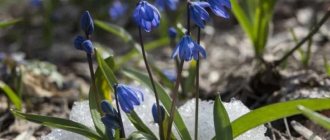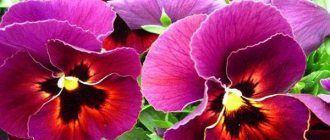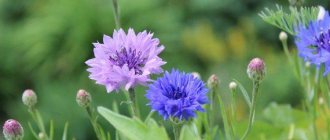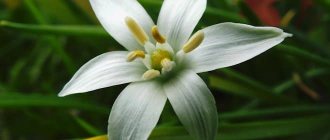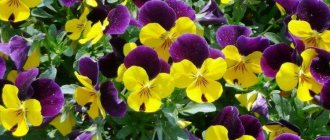Petiole hydrangea (Hydrangea petiolaris), is a species of the genus Hydrangea, a creeping deciduous shrub in the hydrangea family. The species is native to the forests of Japan, the Korean Peninsula and Taiwan. The flowering period is from June to July.
Hydrangea is sometimes called a subspecies closely related to Hydrangea anomala from China and the Himalayas, called Hydrangea anomala subsp. petiolaris. From the petiole hydrangea, the rejected hydrangea differs in size (the rejected petiole grows up to 12 m) and the diameter of the inflorescence is up to 15 cm.
Description
Petiolate hydrangea is a climbing plant with a height of 9–15 (up to 20) meters. Attached to the support by aerial roots. The leaves are glossy, broadly ovate, pointed, serrated with a long petiole, deciduous. The inflorescences are flat, approximately 20 cm. White sterile flowers have a circumference of 2.5–4.5 cm; in the center of the inflorescence there are smaller whitish fertile flowers with a diameter of 1–2 mm. The fruits are capsules, the seeds are small.
The dark green, glossy leaves of Hydrangea petiolate bloom in the spring, earlier than other deciduous climbing plants (for example, Maiden grape). The leaves are heart-shaped, smooth, long with serrated edges. Leaf density varies from plant to plant depending on the immediate growing conditions. Side branches tend to grow at right angles to the main vines.
The shoots form an uneven foliage pattern that is not possible with common climbing plants such as Maiden's Grape or Common Ivy. Petiolate hydrangea begins to bloom in June earlier than other frost-resistant hydrangeas. The inflorescences, usually 15 cm or more in diameter, consist of several hundred small fertile flowers surrounded by a crown of a dozen or more sterile ones. The sterile flowers are white, on long stalks, emphasizing their peripheral position.
The calyxes of sterile flowers are greatly enlarged, up to 2.5 cm in length and almost the same width, and have rounded outlines. The white color persists long after the fruiting flowers have faded, giving the impression of an unusually long flowering period.
The fruit is unattractive and technically a capsule (2.5 cm long). In winter, the stems and side branches have an interesting pattern, the yellowish-orange bark unevenly peeling off into large thin flakes.
Helpful information
You can read other materials about garden hydrangea:
- How to properly care for Bobo paniculata hydrangea? Growing and preparing for winter
- How to properly care for Limelight hydrangea?
- How does Oakleaf hydrangea overwinter?
- Frost-resistant hydrangea Pinky Winky on your site
- Hydrangea paniculata grandiflora - features of care and propagation in the garden plot
- Tree hydrangea Annabelle - a snow-white decoration for your site
- Tree hydrangea in your garden - planting and care, propagation, wintering
- How to make friends with serrated hydrangea?
- Japanese hydrangea Kyushu in your garden
- Frost-resistant large-leaved hydrangea
- How to properly care for paniculate phantom hydrangea? Planting, wintering, reproduction
- How to properly care for paniculate hydrangea vanilla fries?
- Fragrant “princess” hydrangea paniculata in your garden: care features
- Secrets of propagating garden hydrangea
- Garden hydrangea: planting and care, neighborhood in the garden
- Don't let your garden hydrangea freeze! How to cover hydrangea for the winter?
- How to protect garden hydrangea from diseases and pests?
Story
Hydrangea petiolaris, a species known as the "climbing hydrangea," was introduced into horticulture in the United States in 1865 by Thomas Hogg, who was consul to Japan and, with his brother James, ran a nursery in New York. In addition to their own nursery, the brothers distributed seeds at Parson's Nursery in Flushing, New York. The Arboretum received seeds from Japan (presumably subspecies petiolaris) and has been growing it as a species since then. According to Haworth-Booth, Hydrangea anomala subsp. anomala was introduced to Britain in 1839 with subsp. peliolaris around 1878.
Similar, but not her! Be careful when purchasing: Schizophragma hydrangea
Plants from another close genus Schizophragma are also called hydrangeas. Sometimes, under the guise of petiole hydrangea, you can find Schizophragma hydrangeoides on sale from unscrupulous or simply illiterate sellers. This plant is also from the Hydrangeaceae family, but, unfortunately, it is not winter-hardy at all.
in the photo Schizophragma hydrangea, similar to petiolate hydrangea, but not winter-hardy
Landing
Petiolate hydrangea takes root slowly, may not produce growth for a year or even two and blooms poorly after transplantation, prefers rich, well-drained, moist soil, and will grow in sun or shade. Once established, it has no serious pest problems. In the first two to three years after planting it grows rather slowly, but after rooting it accelerates the growth rate. Tolerates air pollution well and can grow in cities and industrial areas.
The first year or two after planting, growth may be slow or seemingly non-existent. As the bush takes root, especially if the tips of the stems can be securely attached to supports or structures, growth becomes surprisingly fast: 50-150 cm per year.
Before planting climbing hydrangea, the soil should be weeded and dug deep. It is better to plant the vine a little further from the supports, then direct the shoots towards them. The supports themselves must be strong to support the weight of an adult shrub. The distance between plants is 1.5-4 meters. In places exposed to strong gusts of wind, hydrangea shoots may break off their supports and fall to the ground; in such conditions, it is a good idea to tie up the plants.
Why does petiole hydrangea not bloom?
Although most varieties are quite attractive in themselves, hydrangea is usually planted in the garden in order to admire its lush and bright blooms. But it happens that the plant does not bloom, and there are several reasons for this:
- Damage by pests or diseases. If spider mites, aphids and other insects have settled on the plant, or it has suffered from fungal diseases, then it may not bloom. Hydrangea will not have enough strength to form buds.
- Lack of light. Although petiole hydrangea can grow in light shade, flowering can only be achieved from it in the presence of good lighting.
- Excess nitrogen in the soil. If the soil is oversaturated with fertilizers, and in particular nitrogen, the plant will grow quickly, but will not be able to form flowers.
- Incorrect trimming. Heavily dense plants bloom poorly or do not bloom at all. All their energy goes into maintaining the green mass. Also, flowering will not take place if you carelessly cut off annual shoots; it is on them that flower buds are laid.
Important! Petiole hydrangea has good frost resistance, but is vulnerable to return frosts. Therefore, you may not be able to wait for flowering after a cold spring; the buds will simply freeze and will not be able to bloom.
Where to plant?
Liana is great for cladding walls with porous surfaces, landscaping walls and fences, covering trash cans, covering gazebos, covering pergolas, trellises and posts. It looks very picturesque on the trunks of old trees. Climbing hydrangea is a good alternative to ivy; unlike ivy, it almost never freezes.
Hydrangea should not be planted too close to tree trunks or building walls; in these places the plant may experience a lack of water.
Care
Climbing hydrangeas are relatively easy to grow. It is especially important to choose the right place so that the vine does not cause serious problems in the future. The shrub grows best in partial shade or shade, in a place protected from the wind. Young specimens are especially susceptible to drought and require regular watering. The species is completely hardy in USDA zone 4, but may not bloom in USDA zone 8.
When the vine reaches the upper limits of available support, climbing hydrangea reacts in the same way as ivy: it switches from vegetative growth to sexual maturity and produces flowers. Thus, a climbing hydrangea climbing a 10-meter-tall tree trunk may not bloom as quickly as one that only has a meter-long pole to climb. If flowering is a priority, provide relatively short support structures such as a 3-5 meter pole or wide ones such as stone walls.
Proper fertilizer is important when planting petiolate hydrangea next to a tree; due to tree competition, the soil can quickly run out of nutrients. Hydrangeas can be fertilized with well-decomposed compost or manure. Also mineral fertilizers for hydrangeas. All-purpose fertilizers are not suitable due to their calcium content. Excess calcium in the soil quickly leads to chlorosis (slight discoloration) of the leaves. Hydrangeas are fertilized from spring to mid-July. Then the plant is allowed to rest before winter.
The moving stems are amazingly inflexible and can break when trying to straighten them. To make matters worse, the older and thicker the stems become, the more brittle they become.
Climbing hydrangeas usually do not require pruning . If you need to limit its growth or give it shape, you can prune it when the vine finishes flowering.
Propagation of climbing hydrangea . Like other types of hydrangea, it can be propagated by summer cuttings. However, in amateur conditions it is easier to use layering.
Pests and diseases
Common diseases of petiole hydrangea include the following:
- Chlorosis — there are several sources of this disease (viruses, fungi, vector pests), and it can also occur due to a lack of minerals in the soil (iron, magnesium). The leaves turn yellow and fall prematurely, shoot growth activity decreases, and the tops dry out. In case of non-infectious damage, special fertilizers will help; in case of infectious damage, the infected plants are destroyed.
- Gray rot - this disease affects the entire plant, gray-brown dry spots appear on it, over time they become wet and covered with plaque. Measures to combat the disease include spraying with solutions of “Fitosporin-M”, “Alirin-B”, “Euparen multi”, “Fundazal”. Affected parts must be cut off and burned.
- White rot - a fungal disease caused by the sclerotonia fungus. It first attacks the roots, then the entire plant. The above-ground part is covered with a white coating, and the underground part is covered with a mucous mass; in damp weather, the bush rots and dies. To combat the disease, “Topsin”, “Previkur”, “Ridomil Gold”, “Profit Gold” are used.
- Root-knot nematodes - small worms about 2 mm long, infect the roots, swellings appear on them, which eventually rot and die. You can fight these pests with the help of the drugs “Nematofagin BT”, “Nematorin”, “Bassamil”.
Reproduction by layering
Since old stems are notoriously fragile, in early spring you need to select a young, thin stem that is low, long and flexible enough so that the shoot can be easily bent to the ground. Place the brick on the soil-covered stem to support it (if necessary) and to prevent rain from washing away the soil. Drive a thick stake into the ground next to the buried vine, covered with soil, and tie the top of the stem to it as close as possible without breaking the stems; if there is support, the vine will take root faster.
Use in the garden
Petiolate hydrangea can be effectively used as a ground cover plant in hard-to-reach places. Good for stone fences or brick walls, although the growth rate is slower in such areas, the growth rate increases if the vine is wrapped around a tree.
When growing petiole hydrangea, you should take some precautions. In the case of a wall, especially in a building, the vine should be grown on the dark side.
The north or northeast side is better suited for growing. If grown in the south, the bush may be damaged by the sun and perform poorly.
It should be noted that hydrangeas drop all of their leaves as one unit, usually in early winter, which can be a challenge when harvesting. Therefore, planting against a wall behind existing plantings such as Rhododendron and Enkianthus should be avoided. Petiolate hydrangea climbs by means of secondary roots, which, penetrating into the substrate, apparently cause little damage than other climbing plants. Haworth-Booth suggested growing petiolate hydrangea along with beautiful Nasturtium.
A fine example of Hydrangea petiolate grown from seed in 1892 can be seen in the northeast corner of the office building on Jamaica Plain.
Growing a climbing hydrangea on a tree should be started on a mature specimen, since over time the vine will begin to grow quickly and braid all the branches.
How to propagate petiole hydrangea
To increase the population of climbing vines on your site, you can propagate the existing plant without purchasing new seedlings. Basically, gardeners resort to two methods of propagation.
Cuttings
Climbing hydrangea vines propagate well using woody cuttings. At the beginning of summer, a stalk about 15 cm long with at least 2 nodes is cut from a healthy woody stem, the lower leaves are removed and placed in a solution with a root formation stimulator for a day. Then the shoot is planted in a box with a sand-peat mixture, watered and covered with film.
Lianas propagate well from cuttings and seeds
From time to time the film is removed to ventilate the shoot and water it again. When the young petiole vine gets stronger and begins to grow, it is transplanted outdoors, usually the next year.
Seed propagation
The method is used infrequently, since it is difficult to propagate petiole hydrangea from seeds - efforts may not be crowned with success. Purchased seeds are sown in plastic or peat pots with moist nutrient soil, consisting mainly of sand and peat. The container is covered with glass or wrapped in film and placed in a room with a temperature of at least 18 °C.
Before the first shoots appear, the plantings only need to be periodically moistened and ventilated daily. Typically, seedlings appear from the ground after 1.5 months; if you plant the seeds at the end of winter, then in April the seedlings will produce their first leaves.
After the leaves appear, the seedlings can be planted. It is advisable to transfer the plant to the ground only after a year, when the seedlings are properly strengthened.
Lianas are usually transferred to an open area in the second year of life.
